
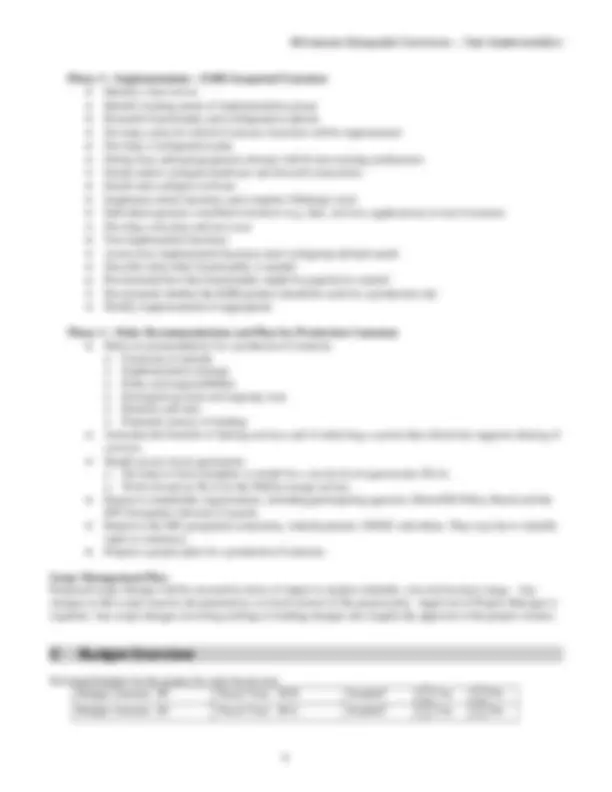
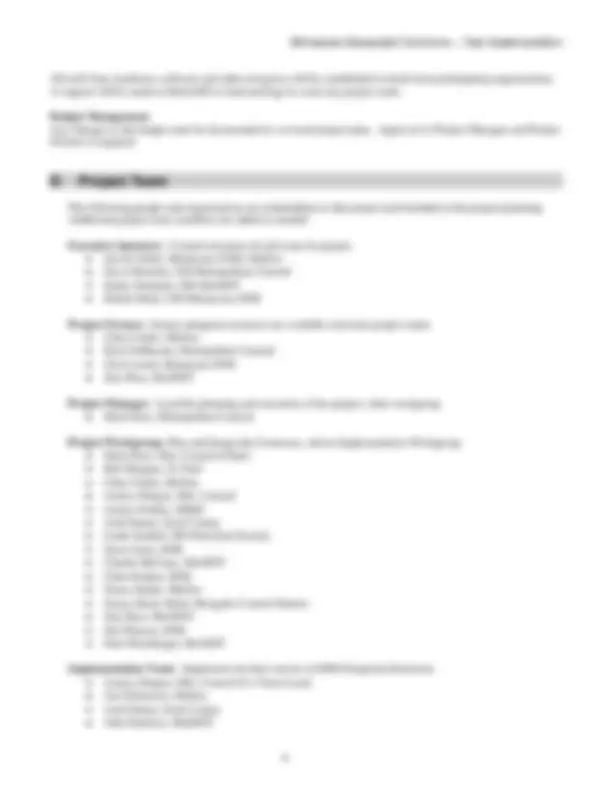
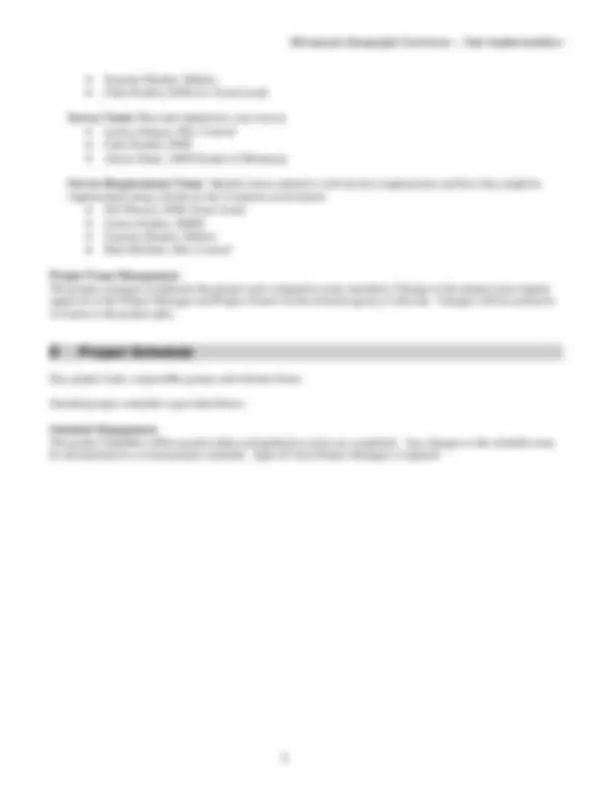
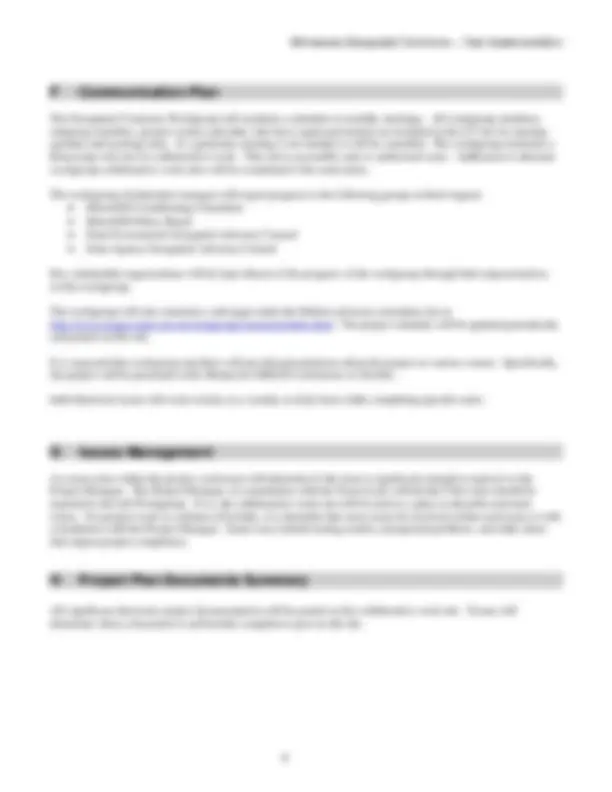
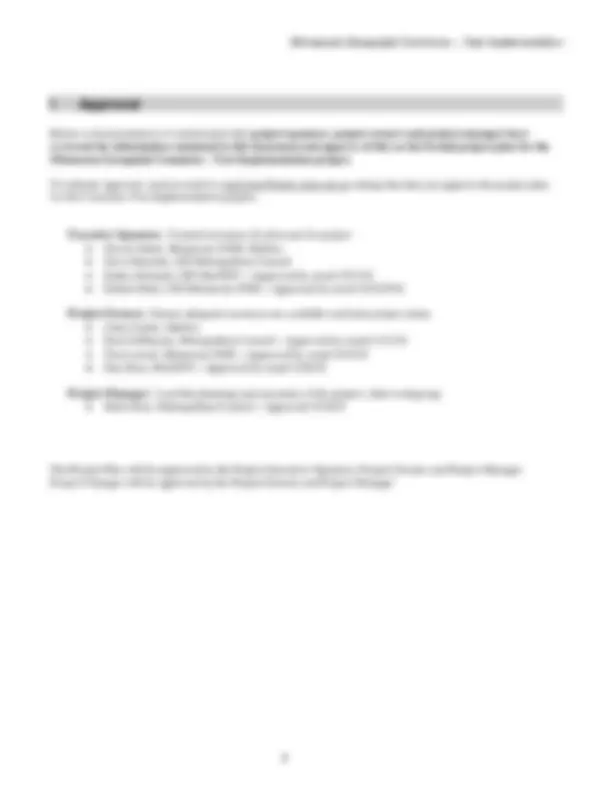


Study with the several resources on Docsity

Earn points by helping other students or get them with a premium plan


Prepare for your exams
Study with the several resources on Docsity

Earn points to download
Earn points by helping other students or get them with a premium plan
Community
Ask the community for help and clear up your study doubts
Discover the best universities in your country according to Docsity users
Free resources
Download our free guides on studying techniques, anxiety management strategies, and thesis advice from Docsity tutors
Project Plan. Project Name: Minnesota Geospatial Commons – Test Implementation. Date: 06/07/2010 Version: 1.3. Prepared By: Mark Kotz.
Typology: Summaries
1 / 9

This page cannot be seen from the preview
Don't miss anything!






Project Name: Minnesota Geospatial Commons – Test Implementation
Date: 06/07/2010 Version: 1.
Prepared By: Mark Kotz
Business Need/Opportunity The Minnesota geospatial community has access to a large number of shared geospatial datasets, mainly through multiple data download sites. However, no one web location exists through which people and organizations can find and share such data. Shared web services and applications are even less accessible, and only modestly promoted as a potential shared resource. There exists in Minnesota a significant opportunity to collaboratively develop a single location through which published Minnesota geospatial resources can be found and shared.
Many in the community are very interested in this opportunity and have a compelling business need to see it succeed, not the least of which are the agencies that manage the biggest GIS data distribution sites in the state (DNR, Met Council, MnGeo & Mn/DOT). Further, the existence of a collaboratively developed Commons may eliminate the need for existing, disparate GIS data download sites, saving several organizations from the responsibility of maintaining their own sites and upgrading them periodically.
The coordinated geospatial commons that is envisioned would greatly advance our ability to share web services in particular, by both providing a place to publish information about them and also by facilitating assessments of the reliability and trustworthiness of such web services. The increased usage of web services will produce efficiency gains for many organizations, in particular those that develop geospatial applications.
Perhaps most importantly, the Commons will provide a one stop location for a broad array of business and GIS users in Minnesota and beyond, whether professional or casual, to find and share useful resources, and will promote greater sharing of geospatial data, services and applications.
Statement of Work This effort includes the following: Define the needed functions of the Commons o Begin with those functions needed by the major data producers o Get additional input from the broader MN geospatial community Assess existing sites and products and choose a product for a test bed implementation Further define the critical functions and requirements (i.e. role of the broker, services documentation) Form a multi agency implementation team advised by the Commons workgroup Create and approve a project charter Create and approve a project plan for the test bed implementation Implement a test bed Commons focusing on high priority functions Test functionality and assess strengths and deficiencies of software product and implementation methods Make recommendations and project plan for a full production Commons, including o Roles and responsibilities o Functions to include o Implementation methods o Timeline
o Governance Report findings Seek commitment and/or funding
This effort does not include the following: Implementing a final production Commons
Project Objectives Business Objectives for the project are: Define the needed functions of the Commons Implement a test bed version of the Commons Make recommendations and develop a project plan for a full production Commons Report to MnGeo and the geospatial community
Constraints The following limitations and constraints have been identified for this project: The effort relies on voluntary participation by multiple government agencies This project has no defined budget This project will proceed within the bounds of the prioritized Commons functional requirements previously defined by the Geospatial Architecture Workgroup Upon approval of this Project Charter, the next milestone will be the completion of a Project Plan.
Assumptions The following assumptions were made when developing this Project Charter: This project has the approval of MnGeo to host the test bed Commons. Participating agencies will continue to support staff involvement with this project. More specific staff commitment levels will be defined in the project plan.
The Project Charter was approved on 3/19/ 2010.
Business Scope
Phase 1 – Requirements Define and prioritize preliminary list of functions Assess user needs and modify functions and priorities if appropriate o Create online survey o Advertize on existing data discovery sites and GIS/LIS newsletter o Compile results and compare to functions list and modify as appropriate. Assess web service requirements o Clarify what comprises comprehensive documentation of a web service. o Agree on a list of key characteristics that must be addressed to achieve “trust” in a web service. o Further define the roles of the Broker (both machine and human) and the Enterprise Service Provider with respect to quality of service and trust. o More clearly define the options for, and recommended functions of the broker and how it interfaces with the service provider and the application client.
All staff time, hardware, software and other resources will be contributed in-kind from participating organizations. A request will be made to MetroGIS to fund staffing for some key project tasks.
Budget Management Any changes to the budget must be documented in a revised project plan. Approval of Project Manager and Project Owners is required.
The following people and organizations are stakeholders in this project and included in the project planning. Additional project team members are added as needed.
Executive Sponsors: Commit resources & advocate for project David Arbeit, Minnesota CGIO, MnGeo Dave Hinrichs, CIO Metropolitan Council Kathy Hofstedt, CIO Mn/DOT Robert Maki, CIO Minnesota DNR
Project Owners: Ensure adequate resources are available and track project status Chris Cialek; MnGeo Rick Gelbmann, Metropolitan Council Tim Loesch, Minnesota DNR Dan Ross, Mn/DOT
Project Manager: Lead the planning and execution of the project, chair workgroup Mark Kotz, Metropolitan Council
Project Workgroup: Plan and design the Commons, advise Implementation Workgroup Mark Kotz, Met. Council (Chair) Bob Basques, St. Paul Chris Cialek, MnGeo Jessica Deegan, Met. Council Jessica Fendos, DEED Josh Gumm, Scott County Leslie Kadish, MN Historical Society Steve Lime, DNR Charlie McCarty, Mn/DOT Chris Pouliot, DNR Nancy Rader, MnGeo Nancy Read, Metro Mosquito Control District Dan Ross, Mn/DOT Hal Watson, DNR Paul Weinberger, Mn/DOT
Implementation Team: Implement test bed version of ESRI Geoportal Extension Jessica Deegan, Met. Council (Co-Team Lead) Jim Dickerson, MnGeo Josh Gumm, Scott County John Harrison, Mn/DOT
Susanne Maeder, MnGeo Chris Pouliot, DNR (Co-Team Lead)
Survey Team: Plan and implement a user survey Jessica Deegan, Met. Council Chris Pouliot, DNR Alison Slaats, 1000 Friends of Minnesota
Service Requirements Team: Identify issues related to web services requirements and how they might be implemented using a broker in the Commons environment Hal Watson, DNR (Team Lead) Jessica Fendos, DEED Susanne Maeder, MnGeo Matt McGuire, Met. Council
Project Team Management The project manager coordinates the project tasks assigned to team members. Changes to the project team require approval of the Project Manager and Project Owner for the affected agency if relevant. Changes will be tracked in revisions to the project plan.
Key project tasks, responsible groups and estimate hours:
Detailed project schedule is provided below.
Schedule Management The project Schedule will be posted online and updated as tasks are completed. Any changes to the schedule must be documented in a revised project schedule. Sign-off from Project Manager is required
Test implemented functions 09/24/10 (^15) Revise any needed implementation pieces 10/01/10 (^)? Revise data or service contributions 10/07/10 (^6) Test Bed running with real data & services - open for comments 10/11/10 (^)?
Give presentation about Commons at MN GIS/LIS Consortium Conference 10/15/10 5 Assess how implemented functions meet workgroup defined needs 11/04/10 (^10) Describe what other functionality is needed 11/04/10 (^10) Modify implementation if appropriate, based on feedback 12/02/10 (^)? Recommend how that functionality might be acquired or created 12/02/10 (^)? Recommend whether the ESRI product should be used for a production site 12/02/10 (^)? Create draft recommendations for a production Commons 12/16/10 (^8) Modify and approve recommendations for a production Commons 01/06/11 (^)? Create draft project plan for a productions commons 01/20/11 10 Modify and approve project plan for a production commons 02/03/11 (^)? Report to stakeholder organizations and geospatial community 02/11/11 (^)? Model service level agreements 02/11/11 2 people (^8) Articulate the benefits of sharing services and a system that supports such sharing
The Geospatial Commons Workgroup will maintain a schedule of monthly meetings. All workgroup members, subgroup members, project owners and other who have expressed interest are included in the CC list for meeting agendas and meeting notes. If a particular meeting is not needed, it will be cancelled. The workgroup maintains a Basecamp web site for collaborative work. This site is accessible only to authorized users. Additional or alternate workgroup collaborative work sites will be considered if the need arises.
The workgroup chair/project manager will report progress to the following groups at their request: MetroGIS Coordinating Committee MetroGIS Policy Board State Government Geospatial Advisory Council State Agency Geospatial Advisory Council
Key stakeholder organizations will be kept abreast of the progress of the workgroup through their representatives on the workgroup.
The workgroup will also maintain a web page under the MnGeo advisory committee site at http://www.mngeo.state.mn.us/workgroup/commons/index.html. The project schedule will be updated periodically and posted on this site.
It is expected that workgroup members will provide presentations about the project at various venues. Specifically, the project will be presented at the Minnesota GIS/LIS Conference in October.
Individual task teams will work closely on a weekly or daily basis while completing specific tasks.
As issues arise within the project, each team will determine if the issue is significant enough to report it to the Project Manager. The Project Manager, in consultation with the Team Lead, will decide if the issue should be reported to the full Workgroup. If so, the collaborative work site will be used as a place to describe and track issues. For project work to continue efficiently, it is desirable that most issues be resolved within each team or with consultation with the Project Manager. Issues may include testing results, unexpected problems, and other items that impact project completion.
All significant electronic project documentation will be posted on the collaborative work site. Teams will determine when a document is sufficiently complete to post on the site.